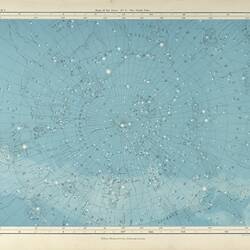Summary
Full title: Atlas of astronomy : comprising, in eighteen plates a complete series of illustrations of the heavenly bodies drawn with the greatest care, from original and authentic documents / by Alex. Keith Johnston ; ed. by J.R. Hind.
The atlas is comprised of 18 rendered plates by W. & A.K. Johnston that are very early and particularly bright instances of chromolithography. The plates show the cause of the seasons and tides, sunspots, the moon, explanations of solar and lunar eclipses, a diagram of the entire solar system, another of the inner solar system, the faces of the known planets (recently expanded in number to 8), comets, nebulae, and 6 plates mapping the positions of the stars and constellations. Contains celestial cartography in the form of regional constellation maps showing the northern and southern hemispheres, from the internal perspective and using the equatorial coordinate system, as follows: No. 1: Area shown: Aries, Pisces, Cetus, Aquarius, Capricorn, Pegasus; No. 2: Area shown: Lynx, Cancer, Canis Minor, Monoceros, Gemini, Taurus, Lepus, Eridanus, Milky Way; No. 3: Area shown: Serpens, Corvus, Canes Venatici, Virgo, Crater, Hydra, Leo, Leo Minor, Sextans; No. 4: Delphinus, Aquila, Aquarius, Capricornus, Serpens, Ophiuchus, Hercules, Lyra, Corona, Libra, Milky Way; No. 5: north circumpolar region, Milky Way; No. 6: southern circumpolar region, Milky Way, and Magellanic Clouds.
Johnston was a Scottish cartographer educated at the University of Edinburgh. He was apprenticed to the Edinburgh engraver and mapmaker, James Kirkwood. In 1826 he and his brother William began in a printing and engraving business, forming the well-known firm of W. and A. K. Johnston, which went on to become one of the major map publishing houses of the 19th century. Johnston was a prolific mapmaker and publisher. He was soon professionally recognised by being appointed Geographer Royal of Scotland. In October 1849 he was elected a Fellow of the Royal Society of Edinburgh and in 1862 he was a founding member of the Meteorological Society of Scotland.
Hind was Superintendent of the Nautical Almanac and is notable for being one of the early discoverers of asteroids and several variable stars, and the first nova of modern times.
The 'Atlas of astronomy' was published in Edinburgh and London by William Blackwood and Sons in 1855 and includes an index.
Physical Description
[4], 16 pages of letterpress and 18 leaves of plates. Contains color illustrations and maps ; 35 cm. Hardbound in quarter calf with gilt-embossed front cover and spine.
Significance
This atlas was a collaboration between two distinguished figures in British astronomy and cartography - the cartographer Alexander Keith Johnston and the astronomer and academician John Russell Hind. Johnston was one of the most important British mapmakers of the nineteenth century. Johnston relied on an astronomer, John Russell Hind, for accuracy in astronomical matters, and it further helped that Hind himself discovered 10 minor planets, including the 30th, Urania, found in July of 1854, while this atlas was being compiled.
More Information
-
Collecting Areas
-
Author
-
Editor
-
Lithographer
-
Inscriptions
Dedication inscribed on flyleaf: "Presented [to the Institute of Applied Science of Victoria] by Miss Helen Calcutt in memory of her father, F.M. Calcutt C.E (was Chief Engineer, Signals, Victorian Railways) 10 November 1971".
-
Category
-
Discipline
-
Type of item
-
Object Dimensions
360 mm (Length), 280 mm (Width)
-
References
[Article] Linda Hall Library. 2022. Scientist of the day - Alexander Keith Johnston.
[Article] Johnston, Alexander K. & Linda Hall Library. 1855. [Digital facsimile] Atlas of Astronomy.
[Web Site] National Library of Scotland. [Website] Maps by W. & A.K. Johnston.
-
Keywords










